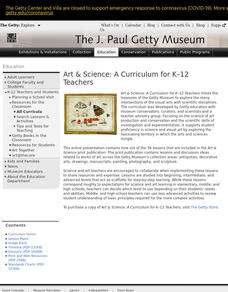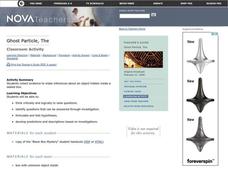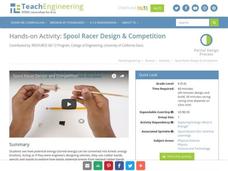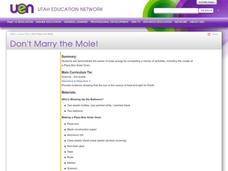Curated OER
Make a Pinhole Viewer
In this light worksheet, students construct a pinhole viewer using a paper box, wax paper, tape and a pushpin. They answer six questions about their observations, the orientation of the images they saw, and the results of their experiment.
Curated OER
The Scientific Method Using Mystery Powders
Students use the scientific method to determine physical and chemical properties of unknown substances. In this scientific method lesson plan, students discuss chemical and physical properties of substances as a class after a...
Curated OER
Energy Efficient Homes
Students observe and gather data from a model simulated home. In this efficiency lesson students examine the factors that influence energy efficiency, complete a lab activity then draw conclusions from their data.
Curated OER
Wind Provides Electricity for Homes, Schools
Students complete a KWL chart, then read a news article about the comeback of windmills. In this current events lesson plan, the teacher introduces the article with a KWL chart and vocabulary activity, then students read the news report...
Curated OER
Surgical Resident for a Day
Pupils simulate the job of surgical resident by using surgical instruments to complete a task inside of a black box using a webcam and flashlight. They complete the task and complete a worksheet.
Curated OER
Capturing Light: The Science of Photography
Students create their own cameras to understand how artists use light to capture an image in a photograph. In this light lesson plan, students use tape, wax paper, rubber bands, and more to create their cameras.
Curated OER
The Ghost Particle
Students collect evidence to make inferences about a object hidden inside a sealed box. They think critically and logically to raise questions. Students identify questions that can be answered through investigation. They formulate and...
Curated OER
Day and Night in the Desert
Learners illustrate scenes showing day and nighttime activities in the desert. They include plant and animal life including predators and prey.
NASA
Photons in the Radiative Zone: Which Way Is Out? An A-Maz-ing Model
Can you move like a photon? Young scholars use a maze to reproduce the straight line motion of a photon. The second in a six-part series of lessons on the sun has learners measure angle of incidence and refraction to determine the path...
Curated OER
It's too loud!
Investigate soft, loud, and dangerous sounds. Little ones put a check next to the sounds that are loud, an X next to ones that are soft, and circle the ones that would require protective ear wear. Tip: Get out a tape player or computer...
Curated OER
Plant Life Cycles
Follow the life cycle of a dandelion with a lab sheet for kindergartners. They learn about the order of events in a dandelion's life, then put the stages of life in order. Can they describe the life cycle of a pumpkin? For extra...
Curated OER
On the Right Circuit
After a discussion on how to make a light bulb light up in an electrical circuit, young scientists take a look at four circuits, and they choose the one they think will make the lightbulb light up. Use in conjunction with any initial...
Teach Engineering
Spool Racer Design and Competition
Wind it up and let it go. Individuals build a basic spool racer in the second portion of a six-part unit on energy. After receiving three criteria, pupils modify their designs to meet the new challenge. Pairs compete against each other...
Dick Blick Art Materials
“Gawu” — African-influenced Tapestry
Here's a great way to combine environmental science with art. Kids use recycled materials to create their own Gawu, a tapestry made of discards. Although designed for special education classrooms, the activity is sure to engage all...
Curated OER
Solar Photovoltaic (PV) Kit
The National Energy Foundation presents this activity, which instructs students to follow directions to connect a solar electric panel to a buzzer. They charge the solar panel to cause the buzzer to sound. The process is repeated with a...
Curated OER
Flowera of the Prairie
Students with severe disabilities view pictures of flowers in a scanning box and identify them. Outside, they locate flowers on the school's property, label and care for them. Students use flower pictures to aid identification.
Curated OER
Penguins
Students read books, learn about the letter p, and eat goldfish crackers all to learn about penguins. In this penguins lesson plan, students also color black and white pictures of penguins.
Curated OER
Don't Marry the Mole!
Third graders demonstrate the power of solar energy by completing a variety of activities, including the creation of a Pizza Box Solar Oven.
Curated OER
MyPyramid for Kids
Students explore healthy food choices. In this science lesson, students identify food groups and discuss the amount of food they should eat from each group. Students create PyramindPal cartoons.
Curated OER
Plant and Animal Communities
Second graders discuss the six main classes of animals: insects, birds, fish, mammals, amphibians, and reptiles. They complete a variety of activities about animals. They solve animal riddles, categorize toy animals, create an animal...
Curated OER
Global Climate Change
Second graders investigate the effect of melting glaciers to sea level. In this earth science lesson, 2nd graders simulate the process in the lab by conducting an experiment using ice cubes and clay. They explain the consequences of...
Curated OER
Survival Under a Rock
Students investigate ways that animals adapt to their environments through hands-on activities using isopods and an interactive video.
Southern Nevada Regional Professional Development Program
Focus: Spelling Common Words
If you’re going to get a tattoo, make sure your artist writes it right because it’s hard to correct their inkings. That’s the big idea in this short lesson plan on commonly misspelled words like their/there/they’re and it’s/its. Images...
Curated OER
Crash of Flight 111
Learners identify the locations on a map of the airplane crashes discussed in this lesson. After watching a video, they discuss the importance of an investigation after a plane crash. They use the same information as the investigators...

























